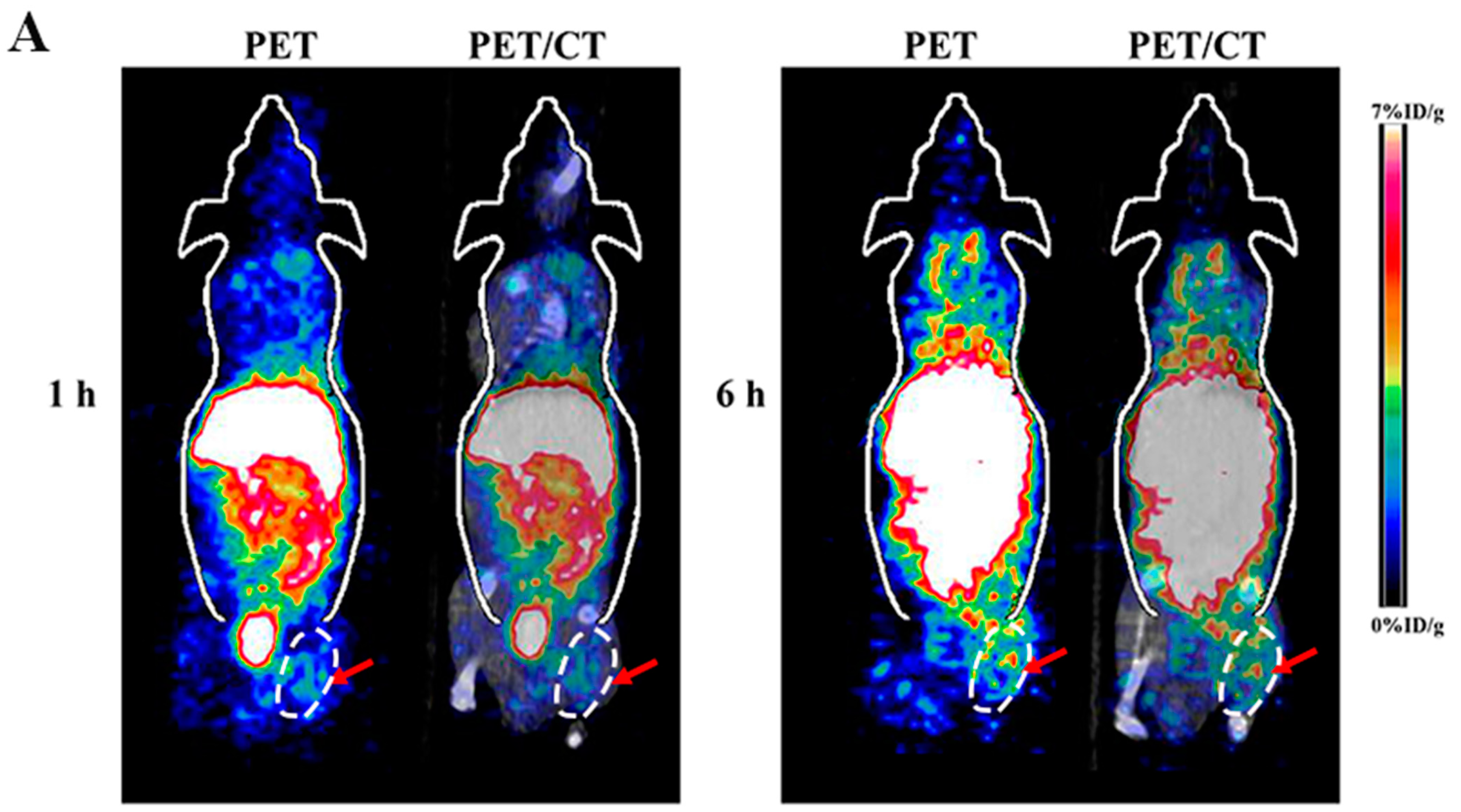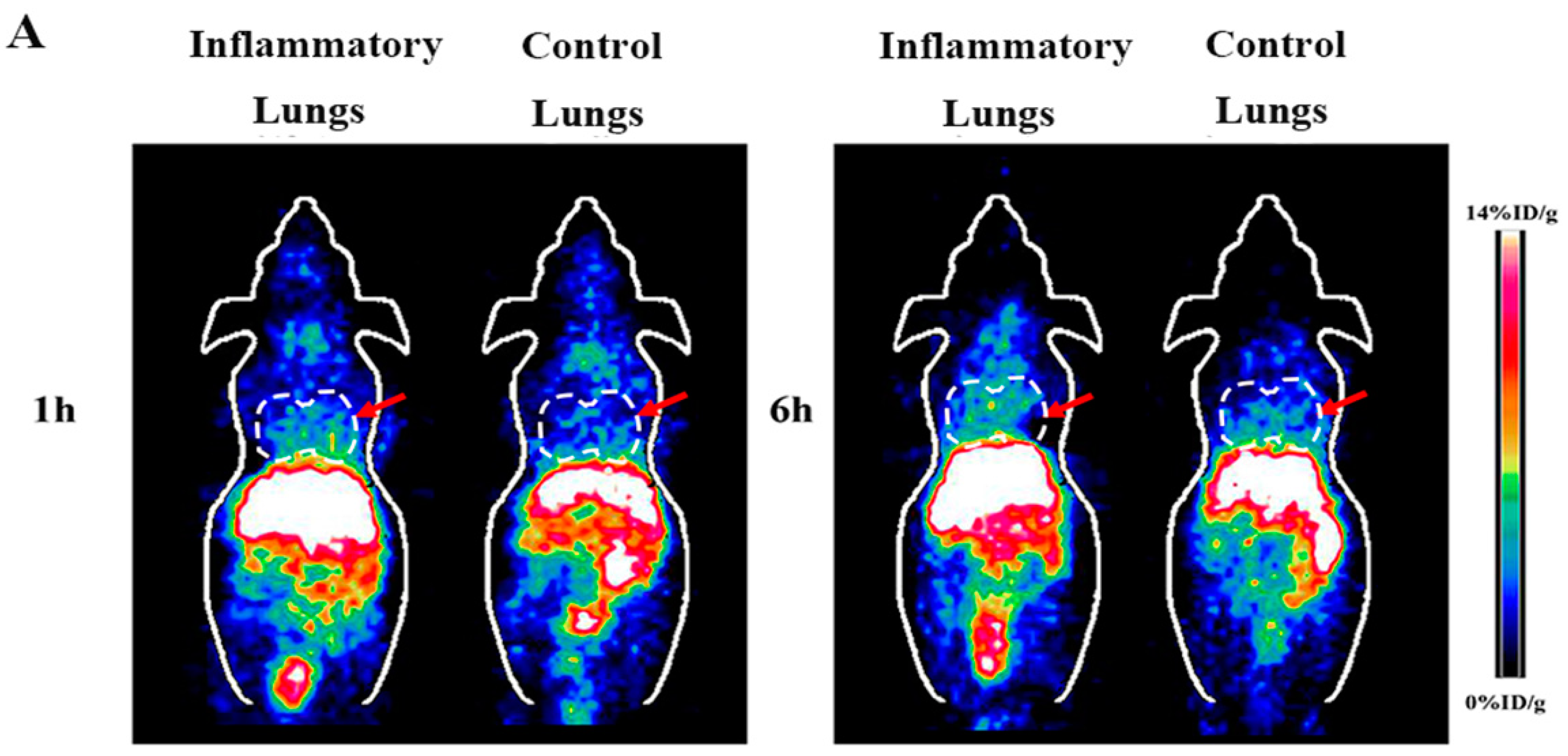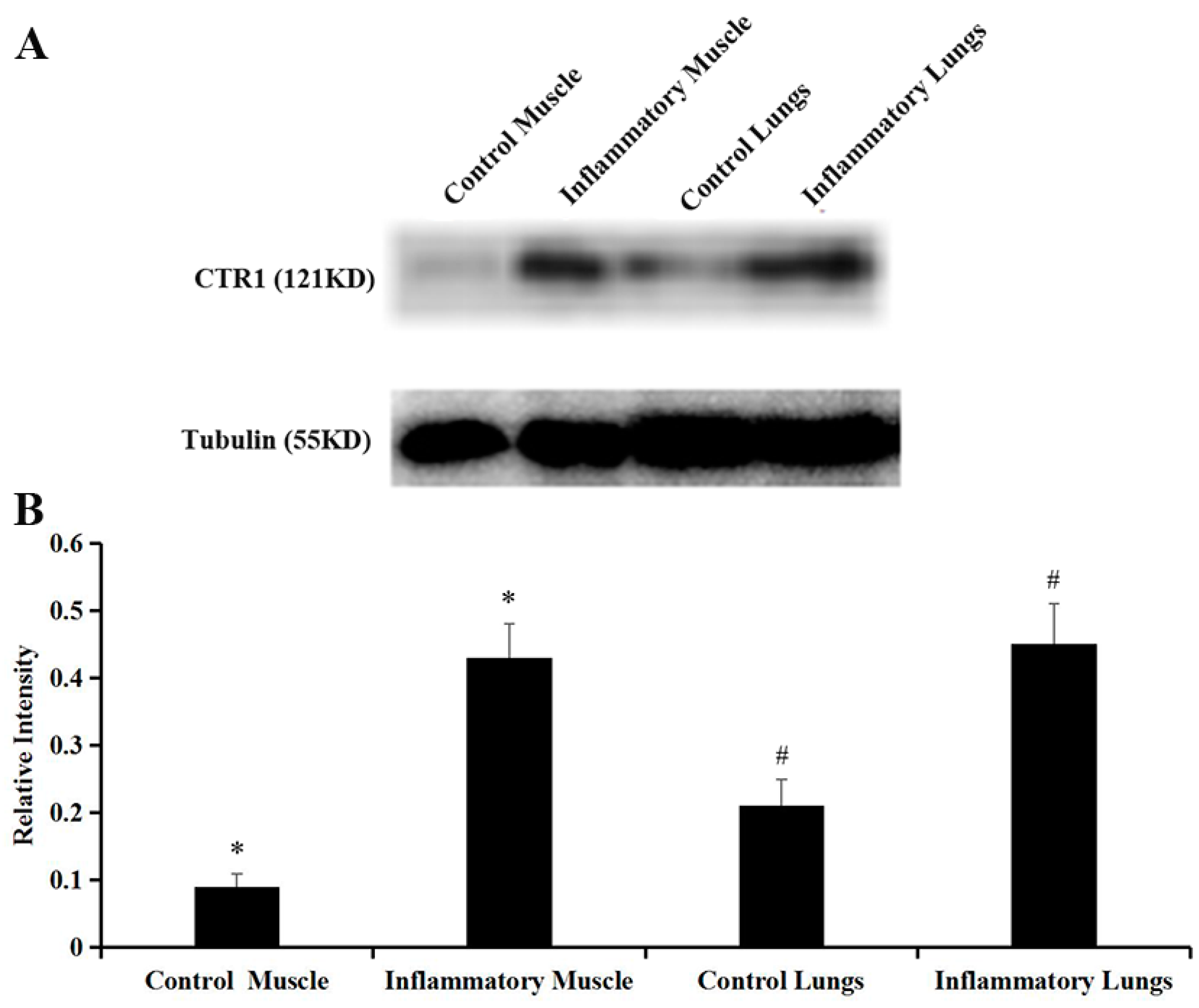Pilot Study of 64CuCl2 for PET Imaging of Inflammation
Abstract
:1. Introduction
2. Results
2.1. Small Animal PET/CT of Inflammatory Muscle
2.2. Small Animal PET of Inflammatory Lungs
2.3. Pathological Results
2.4. Western Blot Analysis
3. Discussion
4. Materials and Methods
4.1. General
4.2. Animal Models of H2O2 Induced Muscle Inflammation
4.3. Animal Models of LPS Induced Lung Inflammation
4.4. Small Animal PET/CT Imaging of Inflammatory Muscle
4.5. Small Animal PET Imaging of Inflammatory Lungs
4.6. Pathology
4.7. Western Blot for CTR1 Levels
4.8. Statistical Analysis
Acknowledgments
Author Contributions
Conflicts of Interest
References
- Linder, M.C.; Hazegh-Azam, M. Copper biochemistry and molecular biology. Am. J. Clin. Nutr. 1996, 63, 797S–811S. [Google Scholar] [PubMed]
- Puig, S.; Thiele, D.J. Molecular mechanisms of copper uptake and distribution. Curr. Opin. Chem. Biol. 2002, 6, 171–180. [Google Scholar] [CrossRef]
- Tsigelny, I.F.; Sharikov, Y.; Greenberg, J.P.; Miller, M.A.; Kouznetsova, V.L.; Larson, C.A.; Howell, S.B. An all-atom model of the structure of human copper transporter 1. Cell. Biochem. Biophys. 2012, 63, 223–234. [Google Scholar] [CrossRef] [PubMed]
- Ruiz, L.M.; Jensen, E.L.; Rossel, Y.; Puas, G.I.; Gonzalez-Ibanez, A.M.; Bustos, R.I.; Ferrick, D.A.; Elorza, A.A. Non-cytotoxic copper overload boosts mitochondrial energy metabolism to modulate cell proliferation and differentiation in the human erythroleukemic cell line K562. Mitochondrion 2016, 29, 18–30. [Google Scholar] [CrossRef] [PubMed]
- Bryan, J.N.; Jia, F.; Mohsin, H.; Sivaguru, G.; Miller, W.H.; Anderson, C.J.; Henry, C.J.; Lewis, M.R. Comparative uptakes and biodistributions of internalizing vs. noninternalizing copper-64 radioimmunoconjugates in cell and animal models of colon cancer. Nucl. Med. Biol. 2005, 32, 851–858. [Google Scholar] [CrossRef] [PubMed]
- Sharp, P.A. Ctr1 and its role in body copper homeostasis. Int. J. Biochem. Cell. Biol. 2003, 35, 288–291. [Google Scholar] [CrossRef]
- Öhrvik, H.; Nose, Y.; Wood, L.K.; Kim, B.E.; Gleber, S.C.; Ralle, M.; Thiele, D.J. Ctr2 regulates biogenesis of a cleaved form of mammalian Ctr1 metal transporter lacking the copper- and cisplatin-binding ecto-domain. Proc. Natl. Acad. Sci. USA 2013, 110, E4279–E4288. [Google Scholar] [CrossRef] [PubMed]
- Squitti, R.; Hoogenraad, T.; Brewer, G.; Bush, A.I.; Polimanti, R. Copper status in Alzheimer’s disease and other neurodegenerative disorders 2013. Int. J. Alzheimers Dis. 2013, 2013, 838274. [Google Scholar] [CrossRef] [PubMed]
- Zheng, Z.; White, C.; Lee, J.; Peterson, T.S.; Bush, A.I.; Sun, G.Y.; Weisman, G.A.; Petris, M.J. Altered microglial copper homeostasis in a mouse model of Alzheimer’s disease. J. Neurochem. 2010, 114, 1630–1638. [Google Scholar] [CrossRef] [PubMed]
- Cai, H.; Wu, J.S.; Muzik, O.; Hsieh, J.T.; Lee, R.J.; Peng, F. Reduced 64Cu uptake and tumor growth inhibition by knockdown of human copper transporter 1 in xenograft mouse model of prostate cancer. J. Nucl. Med. 2014, 55, 622–628. [Google Scholar] [CrossRef] [PubMed]
- Holzer, A.K.; Varki, N.M.; Le, Q.T.; Gibson, M.A.; Naredi, P.; Howell, S.B. Expression of the human copper influx transporter 1 in normal and malignant human tissues. J. Histochem. Cytochem. 2006, 54, 1041–1049. [Google Scholar] [CrossRef] [PubMed]
- Qin, C.; Liu, H.; Chen, K.; Hu, X.; Ma, X.; Lan, X.; Zhang, Y.; Cheng, Z. Theranostics of malignant melanoma with 64CuCl2. J. Nucl. Med. 2014, 55, 812–817. [Google Scholar] [CrossRef] [PubMed]
- Wachsmann, J.; Peng, F. Molecular imaging and therapy targeting copper metabolism in hepatocellular carcinoma. World J. Gastroenterol. 2016, 22, 221–231. [Google Scholar] [CrossRef] [PubMed]
- Jiang, L.; Tu, Y.; Hu, X.; Bao, A.; Chen, H.; Ma, X.; Doyle, T.; Shi, H.; Cheng, Z. Pilot Study of 64Cu(I) for PET Imaging of Melanoma. Sci. Rep. 2017, 7, 2574. [Google Scholar] [CrossRef] [PubMed]
- Zhang, H.; Cai, H.; Lu, X.; Muzik, O.; Peng, F. Positron emission tomography of human hepatocellular carcinoma xenografts in mice using copper (II)-64 chloride as a tracer with copper (II)-64 chloride. Acad. Radiol. 2011, 18, 1561–1568. [Google Scholar] [CrossRef] [PubMed]
- Piccardo, A.; Paparo, F.; Puntoni, M.; Righi, S.; Bottoni, G.; Bacigalupo, L.; Zanardi, S.; DeCensi, A.; Ferrarazzo, G.; Gambaro, M.; et al. 64CuCl2 PET/CT in prostate cancer relapse. J. Nucl. Med. 2017. [Google Scholar] [CrossRef] [PubMed]
- Yahyapour, R.; Amini, P.; Rezapoor, S.; Rezaeyan, A.; Farhood, B.; Cheki, M.; Fallah, H.; Najafi, M. Targeting of Inflammation for Radiation Protection and Mitigation. Curr. Mol. Pharmacol. 2017. [Google Scholar] [CrossRef]
- Milanino, R.; Conforti, A.; Franco, L.; Marrella, M.; Velo, G. Copper and inflammation—A possible rationale for the pharmacological manipulation of inflammatory disorders. Agents Actions 1985, 16, 504–513. [Google Scholar] [CrossRef] [PubMed]
- Conforti, A.; Franco, L.; Milanino, R.; Totorizzo, A.; Velo, G.P. Copper metabolism during acute inflammation: Studies on liver and serum copper concentrations in normal and inflamed rats. Br. J. Pharmacol. 1983, 79, 45–52. [Google Scholar] [CrossRef] [PubMed]
- Gomathy Narayanan, I.; Saravanan, R.; Bharathselvi, M.; Bharathselvi, M.; Biswas, J.; Sulochana, K.N. Localization of Human Copper Transporter 1 in the Eye and its Role in Eales Disease. Ocul. Immunol. Inflamm. 2016, 24, 678–683. [Google Scholar] [CrossRef] [PubMed]
- Kim, E.S.; Tang, X.; Peterson, D.R.; Kilari, D.; Chow, C.W.; Fujimoto, J.; Kalhor, N.; Swisher, S.G.; Stewart, D.J.; Wistuba, II.; Siddik, Z.H. Copper transporter CTR1 expression and tissue platinum concentration in non-small cell lung cancer. Lung. Cancer 2014, 85, 88–93. [Google Scholar] [CrossRef] [PubMed]
- Qaim, S.M. Decay data and production yields of some non-standard positron emitters used in PET. Q. J. Nucl. Med. Mol. Imaging 2008, 52, 111–120. [Google Scholar] [PubMed]
- Smith, S.V. Molecular imaging with copper-64 in the drug discovery and development arena. Expert Opin. Drug Discov. 2007, 2, 659–672. [Google Scholar] [CrossRef] [PubMed]
- Avila-Rodriguez, M.A.; Rios, C.; Carrasco-Hernandez, J.; Manrique-Arias, J.C.; Martinez-Hernandez, R.; García-Pérez, F.O.; Jalilian, A.R.; Martinez-Rodriguez, E.; Romero-Piña, M.E.; Diaz-Ruiz, A. Biodistribution and radiation dosimetry of [64Cu] copper dichloride: First-in-human study in healthy volunteers. EJNMMI Res. 2017, 7, 98. [Google Scholar] [CrossRef] [PubMed]
- Karmpaliotis, D.; Kosmidou, I.; Ingenito, E.P.; Hong, K.; Malhotra, A.; Sunday, M.E.; Haley, K.J. Angiogenic growth factors in the pathophysiology of a murine model of acute lung injury. Am. J. Physiol. Lung. Cell. Mol. Physiol. 2002, 283, L585–L595. [Google Scholar] [CrossRef] [PubMed]
- Peng, F.; Muzik, O.; Gatson, J.; Kernie, S.G.; Diaz-Arrastia, R. Assessment of Traumatic Brain Injury by Increased 64Cu Uptake on 64CuCl2 PET/CT. J. Nucl. Med. 2015, 56, 1252–1257. [Google Scholar] [CrossRef] [PubMed]
- Xie, F.; Cai, H.; Peng, F. 64CuCl2 PET/CT imaging of mouse muscular injury induced by electroporation. Am. J. Nucl. Med. Mol. Imaging 2017, 7, 33–39. [Google Scholar] [PubMed]
- Bass, L.A.; Wang, M.; Welch, M.J.; Anderson, C.J. In vivo transchelation of copper-64 from TETA-octreotide to superoxide dismutase in rat liver. Bioconjug. Chem. 2000, 11, 527–532. [Google Scholar] [CrossRef] [PubMed]
- Kumar, V.; Boddeti, D.K. (68)Ga-radiopharmaceuticals for PET imaging of infection and inflammation. Recent Results Cancer Res. 2013, 194, 189–219. [Google Scholar] [PubMed]
- Chakravarty, R.; Chakraborty, S.; Dash, A. 64Cu2+ Ions as PET Probe: An Emerging Paradigm in Molecular Imaging of Cancer. Mol. Pharm. 2016, 13, 3601–3612. [Google Scholar] [CrossRef] [PubMed]
Sample Availability: Samples of the compounds are not available from the authors. |






© 2018 by the authors. Licensee MDPI, Basel, Switzerland. This article is an open access article distributed under the terms and conditions of the Creative Commons Attribution (CC BY) license (http://creativecommons.org/licenses/by/4.0/).
Share and Cite
Jiang, L.; Song, D.; Chen, H.; Zhang, A.; Wang, H.; Cheng, Z. Pilot Study of 64CuCl2 for PET Imaging of Inflammation. Molecules 2018, 23, 502. https://doi.org/10.3390/molecules23020502
Jiang L, Song D, Chen H, Zhang A, Wang H, Cheng Z. Pilot Study of 64CuCl2 for PET Imaging of Inflammation. Molecules. 2018; 23(2):502. https://doi.org/10.3390/molecules23020502
Chicago/Turabian StyleJiang, Lei, Dongli Song, Hao Chen, Ao Zhang, Huoqiang Wang, and Zhen Cheng. 2018. "Pilot Study of 64CuCl2 for PET Imaging of Inflammation" Molecules 23, no. 2: 502. https://doi.org/10.3390/molecules23020502
APA StyleJiang, L., Song, D., Chen, H., Zhang, A., Wang, H., & Cheng, Z. (2018). Pilot Study of 64CuCl2 for PET Imaging of Inflammation. Molecules, 23(2), 502. https://doi.org/10.3390/molecules23020502




